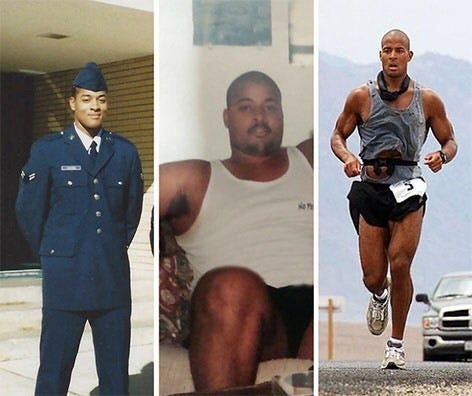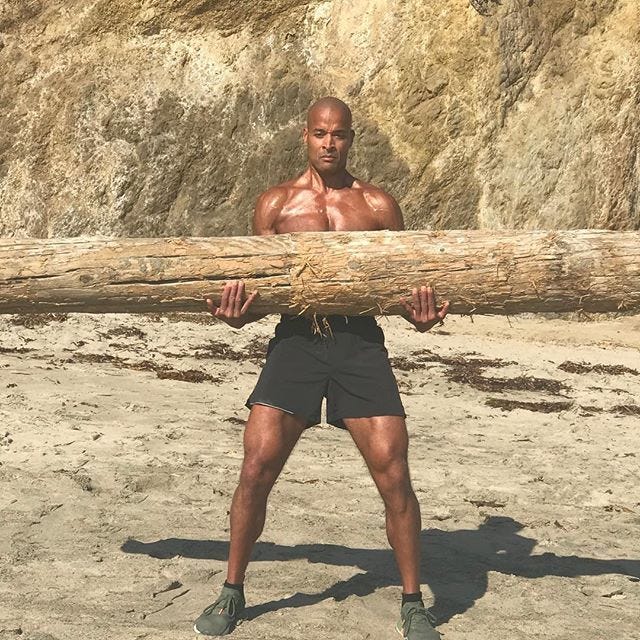In the last issue, I focused on Goggins’ weight loss journey to get into the Navy SEALs, as well as his later achievements in ultra marathons and doing an insane amount of pull-ups. And whilst those things demonstrate the badass kind of person he is, they’re only touching on his deeper philosophy and approach to life – which is what really inspires me about him.

Photo: Instagram/davidgoggins David Goggins has done some ridiculous things in his life. I already mentioned that he taped up his legs and feet so he could not only run on his stress fractures, but go through six months of gruelling Navy SEAL training with them. And I mentioned he ran 100 miles having never even run a marathon (and having not run at all for over a year). He was in a pretty bad way during that 100-mile race, as you can imagine. In fact, he said that at mile 70, he was in the worst shape of his life – or “jacked up”. So he took a break from the race and sat down. Unfortunately, Goggins soon found himself unable to stand, pissing blood down his leg, and shitting himself. Noice. His kidneys had failed, he’d broken the small bones in his feet, and he had excruciating stress fractures in both legs. Eventually, he got up and walked for 10 miles, slowly. But once he realised he wasn’t going to make the 24-hour time on the race, he (again) taped up his ankles and shins – and ran those last 19 miles. His wife had to take him to the hospital afterwards, and it turns out he wasn’t that far from death. So why didn’t he just give up? Here are four techniques he used to keep going.
Technique 1: The cookie jar 🍪🍪

Photo: Instagram/davidgoggins (sans blood and diarrhoea 🎉🎉) One of the techniques Goggins uses is “the cookie jar”. It’s not a real cookie jar (I know 😕), it’s more of a treat for the psyche. Goggins recommends we think back over our lives and make a mental note of all the times we’ve overcome difficult situations. The times we stood up for ourselves, fought back, went harder than we ever thought we could, got through huge challenges and triumphed. At mile 70, when he saw blood and diarrhoea running down his pain-filled legs, Goggins, of course, asked himself why? Why am I doing this? But then he remembered everything he’d already achieved. He tapped into past victories and the emotions he’d felt at the time, pulling each memory from his mind like cookies from a cookie jar. He remembered he’d managed to get through his Navy SEAL training – which gave him just enough energy and drive to get to mile 100. Goggins said he’s “not that kid that got called the N-word anymore” when he’s using the cookie jar – he’s the man who managed to complete hell week while his body was falling apart. If he did it then, he could do it now.
Technique 2: The alter ego 🎭

Photo: Instagram/davidgogginsThis is one of my favourite things David Goggins talks about. If we want to do something we never thought was possible for us, we need to become someone we’ve never been. “I had to invent a guy that didn’t exist”, Goggins said, “I had to invent a guy that could take any pain, any suffering, any kind of judgement”. You’ll notice he’s usually referred to as “David Goggins” or “Goggins” – rarely just “David”. That’s because “Goggins” is the alter ego he created to become the man he is today – a man who “didn’t exist”, but certainly does now. He recommends going into a quiet room and just listening. Listen to your inner voice and all the fearful thoughts it repeats to you. Face them. Face who you are. Then create someone else. It’s still you, but it’s the you who can face anything. “In that dark room is who you are,” Goggins said, “but in that dark room is where you have to create another human being that walks out of that room, to face who you are. That’s the only way you’re going to get over all those things.” Others have witnessed David’s transformation into Goggins, noting how “when shit got hard, he got into this different zone”, becoming “a different person… that’s unstoppable.”
What’s your alter ego?
What does your alter ego look like? What’s their name? And what are the fears it will face for you? I’ve used an alter ego that looks like my favourite childhood cartoon, She-ra, to help me work out every day for 60 days. There’s a whole book about alter egos and the author, Todd Herman, says it’s the fastest way to produce change. He details that Beyonce created the ‘Sasha Fierce’ alter ego to allow her to be more expressive on stage, Eminem created ‘Slim Shady’ to help him face his fears, and apparently, Martin Luther King wore non-prescription glasses to make him feel more distinguished.
Technique 3: Accountability mirror 👤

Photo: Instagram/davidgogginsIn his book ‘Can’t Hurt Me’, Goggins’ first task for the reader, once he’s described his harrowing life story, is to take a look in the “accountability mirror”. This is where Goggins is at his most un-PC – and might be why some people are put off by him. The accountability mirror is where you face yourself and all your fears, all your inadequacies, all the bullshit stories and excuses you tell yourself for why you aren’t who you want to be and aren’t living the life you want to live yet (if you’re already doing both those things then congratulations! Tell me how you got there). “When you look in the mirror, that’s the one person you can’t lie to”, Goggins says. He said you need to be honest with yourself to have a starting point. “Where the fuck am I gonna start from,” he asked himself. And he was pretty harsh with himself, saying things like “I’m dumb”, “I’m fat”, and “I have no courage and no self-esteem” when he first started on his self-improvement journey. But by being honest with himself he was able to face himself and start addressing those things. Any time he noticed something he didn’t like about how he was living his life, he’d write it on a sticky note and put it on his mirror. And he’d fix it.
Technique 4: The 40% rule ⤴️ ⤴️

Photo: Instagram/davidgogginsAnother mindblowing message from Goggins is the 40% rule. Any time you feel like you’re giving something 90%, 95%, or even 100%, you’re actually only giving 40% of what you’re capable of. The mind has a governor, a “factory setting” that protects us from the pain and suffering of pushing ourselves further. “The second the mind senses that oh no this isn’t fun, we should back off, we should sit down… find something more comfortable”, we start to ease off on whatever we’re doing. The mind knows our insecurities, what we’re afraid of, the lies we tell ourselves, and so it protects us from facing that pain, pushing us towards what is comfortable. When we reach 40% our mind tells us we’re done, we’re not good enough to go any further. But what if we say something else to ourselves? What if we say “let me see if I can go to 45%”? If you’re a runner you might have done something like this. You do your 5K, you’re feeling proud, but actually, you’re still 0.5 miles from home. You didn’t think you had it in you, but you run that last half mile and even sprint at the end. That’s the 40% rule in action. It’s stretching your pain tolerance and letting go of self-limiting stories, or the “poopy-pants mentality”, as Goggins puts it – the bullshit excuses we all have for ourselves.
Where could you take your life from 40% to 45%? Remember, it’s not going to feel good in the moment. Which leads us on to…
Technique 4: Embrace the suck 😬

Photo: Instagram/davidgogginsIn life, we’re all looking for the finishing line, Goggins says. The time when we’ve done what we needed to do, achieved “success” (whatever that looks like for us), and we can just chill and enjoy our riches. Isn’t that the dream? No. According to Goggins, there is no finishing line in life. Doing hard things feels shitty in the moment, and pushing ourselves is always uncomfortable – if it isn’t, we’re well within that safe 40%. So we might as well accept that life is going to be difficult and painful. And while we’re still alive, our suffering won’t end. We might as well “embrace the suck”. Goggins talks about being remembered for attacking whatever is in front of you instead of shying away from it. “No matter what was in front of me, I had to figure out a way to overcome it”. When we’re met with challenges, we’re likely to doubt why we’re even doing what we’re doing. “Why am I doing this to myself?” we ask ourselves. Goggins trained his mind to ask “how the fuck can I get through this?” instead. He created a wall in his mind that blocked out all exits, all potential ways out (aka excuses).
But does it have to suck? 😫

Image by OpenClipart-Vectors from PixabayI could write more about Goggins… (part 3 anyone?) – but this issue is getting pretty long and I haven’t worked out yet today 😱. I want to note that Goggins’ philosophy is one of many, and I don’t think it’s necessary to go to the lengths he does to adopt it in useful ways. For example, he runs 20 miles per day – but doesn’t actually enjoy running. He prefers basketball, which he never plays anymore. He stretches for 2-3 hours per day. And, as I’ve mentioned a few times, he’s run 30 miles on broken bones whilst suffering from liver failure. Don’t do that. But maybe what he truly loves about the things he does, and what his purpose is, is to inspire the rest of the world. To make us go all in on our purpose in life. Overall it won’t suck, the end result won’t suck – but when we’re pushing past our excuses and going far beyond our comfort zone, it will feel uncomfortable. Let’s embrace it. 💪
So, until next week… *Goggins voice* – Stay hard!




Incredibly well-written! Will you be writing other articles?
I need a Sasha Fierce!